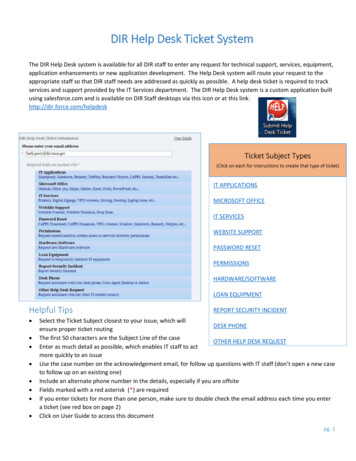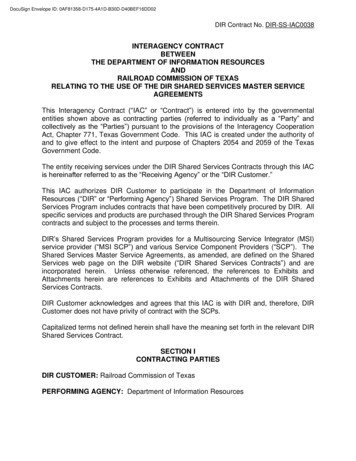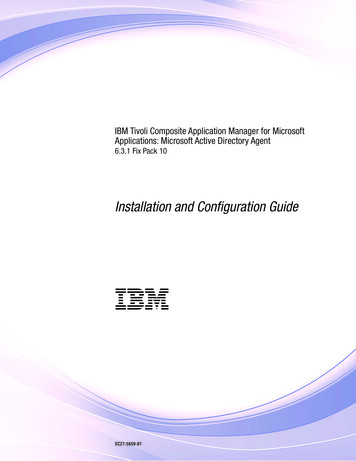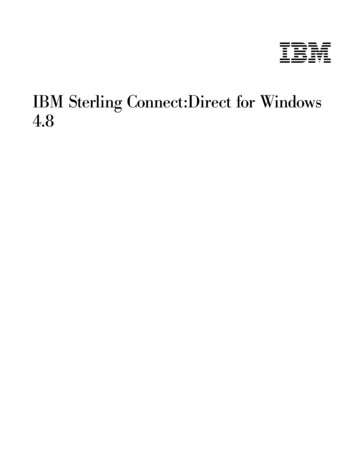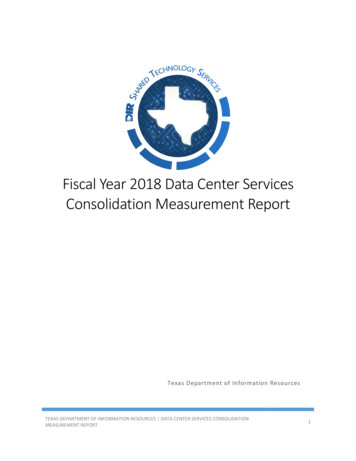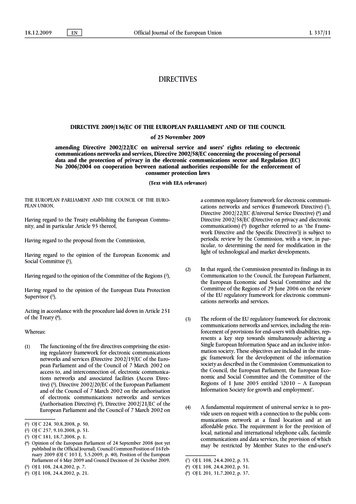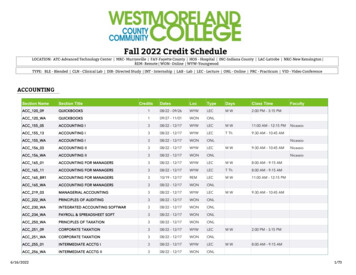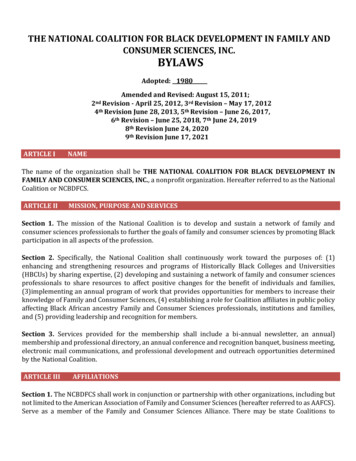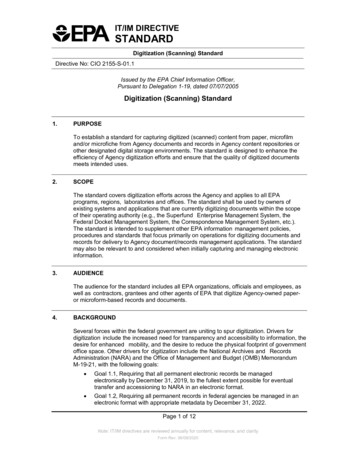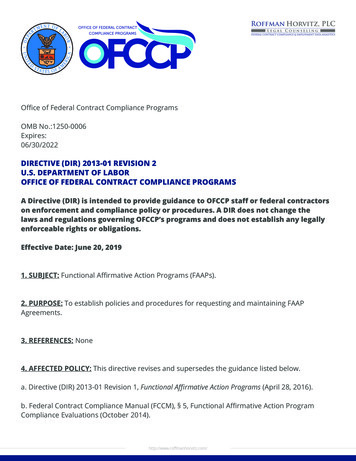
Transcription
Office of Federal Contract Compliance ProgramsOMB No.:1250-0006Expires:06/30/2022DIRECTIVE (DIR) 2013-01 REVISION 2U.S. DEPARTMENT OF LABOROFFICE OF FEDERAL CONTRACT COMPLIANCE PROGRAMSA Directive (DIR) is intended to provide guidance to OFCCP staff or federal contractorson enforcement and compliance policy or procedures. A DIR does not change thelaws and regulations governing OFCCP’s programs and does not establish any legallyenforceable rights or obligations.Effective Date: June 20, 20191. SUBJECT: Functional Affirmative Action Programs (FAAPs).2. PURPOSE: To establish policies and procedures for requesting and maintaining FAAPAgreements.3. REFERENCES: None4. AFFECTED POLICY: This directive revises and supersedes the guidance listed below.a. Directive (DIR) 2013-01 Revision 1, Functional Affirmative Action Programs (April 28, 2016).b. Federal Contract Compliance Manual (FCCM), § 5, Functional Affirmative Action ProgramCompliance Evaluations (October 2014).http://www.roffmanhorvitz.com/
25. BACKGROUND: OFCCP is encouraging the use of functional or business unit based affirmativeaction programs (AAPs). A functional AAP agreement can be an attractive alternative to havingan establishment-based AAP for several reasons. OFCCP’s FAAP program allows a company thatis a covered federal contractor or subcontractor to organize its AAP to reflect how the companyoperates functionally and not where its facilities and people are physically located.1 A companywith a FAAP may find that it is easier to organize and analyze data, identify issues, establish clearlines of responsibility for implementing its AAP, and monitor progress. There is also the benefitof having the flexibility to combine the use of FAAPs and establishment-based AAPs.This Directive establishes a FAAP request process that is simple, fluid, and collaborative. OFCCPand the contractor work together to reach decisions related to the request and how it might beimplemented once approved. This supports the prompt, transparent, and consistent applicationof OFCCP’s policies and procedures. Moreover, OFCCP can provide compliance assistancebefore, during, and after the FAAP agreement request process.OFCCP’s Executive Order 11246 regulations permit federal supply and service contractors todevelop AAPs based on a business function or business unit. Generally, to be suitable for a FAAP,the functional or business unit must exist and operate autonomously. In addition, it must: Have at least 50 employees;Have its own managing official; andHave the ability to track and maintain its own personnel activity.This approach is different from the most commonly used approach of creating AAPs based onthe contractor’s establishments or locations.2 Specifically, the regulation at 41 CFR 60 2.1(d)(4)provides:3If a contractor wishes to establish an affirmative action program other than byestablishment, the contractor may reach agreement with OFCCP on the developmentand use of affirmative action programs based on functional or business units. TheDeputy Assistant Secretary, or his or her designee, must approve such agreements.Agreements allowing the use of functional or business unit affirmative action programscannot be construed to limit or restrict how the OFCCP structures its complianceevaluations.Any supply and service contractor subject to OFCCP’s AAP requirements may request a FAAPagreement that permits the development and use of AAPs based on functional or business units.Some contractors may find it appropriate to develop AAPs based solely on functional or businessunits, while others may elect to use a combination of both functional units and establishmentbased AAPs. In the absence of an approved FAAP agreement, the regulations require contractorsto develop, implement, and maintain separate AAPs for each physical location or establishmentwith 50 or more employees.
36. ROLES AND RESPONSIBILITIES:a. The Contractor is responsible for:i. Submitting a complete and timely request for a FAAP agreement.ii. Implementing the FAAP agreement after receiving a copy of the agreement signedby the Director of OFCCP.iii. Certifying in writing, as a part of the FAAP agreement certification process, thatthere are no changes in the contractor’s functional or business units, structure ororganization, or other circumstances that would affect the FAAP.iv. Managing and monitoring all personnel actions, including recordkeeping andaffirmative action responsibilities for all functional or business units regardless ofsize.v. Complying with the affirmative action requirements of EO 11246, as well as Section503 of the Rehabilitation Act of 1973, as amended (Section 503) and the VietnamEra Veterans’ Readjustment Assistance Act of 1974, as amended (VEVRAA) if thecontractor meets the written AAP thresholds for these laws.4vi. Identifying and providing information about the forms and formats (e.g., Excel,Word, Access, the use of third party vendors for payroll and human resources datareporting, etc.) in which the contractor maintains information requested by OFCCP.The contractor will provide information in one or more of the available forms andformats, as requested by OFCCP.vii. Submitting all requested information, including applicant flow, hire, promotion, andtermination, and compensation data, electronically (e.g., email or uploaded to site)to OFCCP. If electronic submission is not possible or feasible, the contractor andOFCCP should agree to an acceptable alternative.b. OFCCP is responsible for:i. Notifying the contractor upon receiving its request for a FAAP agreement.ii. Reviewing and recommending action on a contractor’s request to develop, modify,and certify a FAAP agreement.iii. Approving or otherwise disposing of requests related to FAAP agreements.
4iv. Notifying the contractor within 60 days of receiving a complete FAAP packageregarding its decision on the agreement.v. Using the information that a contractor provides in support of its request for aFAAP agreement solely to evaluate that request.vi. Determining whether a contractor is currently reporting its compliance under therequirements of a conciliation agreement when determining whether to approve aFAAP agreement.vii. Providing compliance assistance and conducting compliance evaluations.7. DEFINITIONSTo ensure clarity and consistency in the implementation of the FAAP program, definitions forcommonly used terms in OFCCP programs are provided below.Certification – A written notice from the contractor to OFCCP confirming that the contractor willcontinue to operate under a functional or business unit structure. OFCCP will review the noticeand determine whether to issue a new FAAP agreement for a new five-year term.Compliance Evaluation – The investigation and review process used by OFCCP to determine if afederal contractor is complying with the nondiscriminatory and affirmative action employmentobligations outlined in 41 CFR Chapter 60. A compliance evaluation consists of any one or anycombination of the following investigative procedures: compliance review, off-site review ofrecords, compliance check, or focused review.5Compliance Review – A comprehensive analysis of the hiring and employment practices of thecontractor, including the contractor’s written affirmative action program (AAP), and the results ofthe affirmative action efforts undertaken by the contractor. A compliance review may proceed inthree stages: desk audit, onsite review and offsite analysis.6Establishment – A facility or unit that produces goods or services, such as a factory, office,store, or mine. In most instances, the unit is a physically separate facility at a single location. Inappropriate circumstances, OFCCP may consider as an establishment several facilities located attwo or more sites when the facilities are in the same labor market or recruiting area. OFCCP willdetermine whether it is appropriate to group facilities into a single establishment on a case-bycase basis.7Functional or Business Unit – A component within an organization that operates autonomouslyin the ordinary course of the organization’s business. A functional or business unit should
5also have identifiable personnel practices or transactional activities specific to the functionalor business unit (e.g., applicant flow, hires, promotions, compensation determinations,terminations, etc.) that are distinguishable from other parts of the contractor. Functions orbusiness units should be identified and defined based on the organization’s existing businessoperations, personnel practices and management structures.Modification – A modification to a FAAP agreement is necessary when a contractor makes achange to its functional units or structure that creates, eliminates, or changes one or morefunctional units. This change could be the result of a reorganization, merger, acquisition, ordivestiture.8. POLICY: A contractor’s Executive Order 11246 FAAP must include the required AAP elementsdescribed in 41 CFR 60-2. If a contractor is also required to have an AAP under Section 503,VEVRAA, or both, the contractor must develop FAAPs that meet the requirements in Subpart C of41 CFR 60-300 and Subpart C of 41 CFR 60-741, as applicable.A contractor must follow the policies and procedures established in this Directive to obtain anagreement to establish a FAAP. Certain basic principles apply to the FAAP process. The approval of FAAP agreement requests, modifications, and certifications by OFCCPis not automatic. The Director of OFCCP, or his or her designee, must affirmativelyapprove these submissions within 60 days of receiving a complete package. The denialof a request does not prohibit a contractor from seeking a FAAP agreement for asubsequent AAP year. A FAAP agreement must cover all employees in the contractor’s workforce that arein the identified functional or business units. However, this does not mean that theentire workforce must be covered by FAAPs. In some cases, it may be appropriate for acontractor to use both FAAPs and establishment-based AAPs. Only functional or business units identified in the approved FAAP agreement arecovered by that agreement. A contractor must continue to develop, implement, and maintain AAPs for eachestablishment until the FAAP agreements become effective (i.e., when signed byOFCCP’s Director). A FAAP agreement expires five years after its effective date, unless certified by the endof that period. A FAAP agreement does not relieve a contractor of its obligation to comply withthe regulations at 41 CFR Chapter 60. OFCCP does not negotiate its procedures for
6determining compliance with its regulations. A FAAP agreement cannot contain provisions that limit OFCCP’s access or the mannerand means by which it initiates and conducts compliance evaluations. These mattersare non-negotiable. FAAP units that have undergone a compliance evaluation will be exempt from anotherevaluation for 36 months from the date OFCCP closed the previous evaluation. Thisexemption does not prohibit OFCCP from conducting complaint investigations andcompliance evaluations based on credible third party evidence.9. PROCEDURES: Contractors requesting, modifying, certifying, or terminating a functional AAPagreement must follow the procedures outlined in this Directive.a. Procedures for Requesting a Functional AAP Agreement:i. The contractor requesting a FAAP agreement must submit a written request to theDirector of OFCCP. The request must include proof of contract coverage and thename and contact information for the corporate representative responsible foroverseeing the contractor’s request for the FAAP agreement. The contractor mustaddress the written request to the Director of OFCCP and submit it by email toOFCCP FAAP-UNIT@dol.gov.ii. The contractor’s request must describe in detail how the proposed functionscorrelate to the contractor’s specific organizational structure. In addition, therequest must include an organizational chart, specific information about thefunctional or business units, functional unit locations and addresses, the numberof employees, a transition plan describing the process and timeframes in which theorganization will move from establishment-based AAPs to FAAPs. Attachment A,Documentation to Submit with a FAAP Request, lists specific items for submitting withthe request. OFCCP may, if it is necessary, request additional information beforemaking a final determination on the contractor’s request.8iii. OFCCP must receive the request for a FAAP agreement no later than 120 calendardays prior to the expiration of the contractor’s current corporate headquarters AAP.If the contractor making the request is a first-time contractor, OFCCP must receivethe request within 120 calendar days from the award of the Federal contract.OFCCP will deny a request that is not timely submitted.iv. OFCCP will send written notification to the contractor when the requested FAAPagreement is approved; the actual agreement will be attached to this notice.OFCCP has 60 calendar days from the time the complete FAAP request package is
7received to notify the contractor of its decision to grant or deny the request. Thecontractor must sign the FAAP agreement and return it to OFCCP for signature bythe agency’s Director. The agency will provide a copy of the agreement, with all ofthe required signatures, to the contractor. The FAAP agreement is effective on thedate it is signed by OFCCP’s Director. The contractor has 120 calendar days fromthe effective date to implement its FAAP. The contractor must notify OFCCP whenits FAAP is implemented.v. OFCCP will continue to schedule and conduct establishment-based complianceevaluations during the review and approval stage of a FAAP agreement request,and the 120 calendar day FAAP implementation period. Should a scheduling letterbe received during the review and approval stages (i.e., after submission of theFAAP request but before the effective date of the agreement) the evaluation will becompleted as establishment-based evaluation. A contractor receiving a schedulingletter during the 120 calendar day FAAP implementation period may have itsscheduled establishment-based compliance evaluation administratively closed.vi. The denial of a contractor’s request does not prohibit the contractor from seeking aFAAP agreement for a subsequent AAP year.b. Modifying a Functional AAP Agreement:i. A change in the functional or business units, or structure or organization of acontractor that affects an existing FAAP agreement requires a modified agreement.A contractor is required to notify OFCCP, in writing, within 60 days of the effectivedate of the change. The FAAP agreement will be modified to reflect the changes.ii. The modification notice must include a description of and the reason for thechange. If functional units were changed, added, and/or removed the contractor’snotice must state when the new FAAPs will be in place. If functional units wereremoved, the contractor must identify where those employees will be covered inthe new FAAP structure. If there was a merger, acquisition, and/or downsizing,the contractor must provide OFCCP the name of the newly merged or acquiredcompany and the contractor’s plan to incorporate the former company’s employeesinto its AAP structure. Any resulting functional or business unit name change, andchanges in managing officials, employee counts, and addresses should be includedin the modification notice.iii. Modifications to the FAAP agreement do not extend the five-year term of a FAAPagreement.iv. OFCCP could schedule a contractor for a compliance evaluation should thecontractor fail to submit a modification notice. Should there be repeated failures to
8inform OFCCP of a modification, the agency could terminate the contractor’s FAAPagreement.c. Certifying a Functional AAP Agreement:i. The contractor must certify in writing, and submit electronically via email to OFCCP,that there were no changes made to its functional or business structure, structureor organization, or other circumstances that affect the existing FAAP agreement.The certification must also state that the contractor wishes to continue to operateunder a functional AAP structure.ii. If there were changes that resulted in the modification, addition or elimination offunctional units or establishment-based AAPs, the contractor is required to submita written statement providing the rationale for the changes. The certification mustinclude updated information regarding employee counts, facility names, and facilityaddresses included in each functional unit. OFCCP will review the information andconfirm that the changes meet the criteria outlined in Section 9 of this Directive.OFCCP will work closely with the contractor’s designated representative to ensuretimely and proper processing of the certification request.iii. The contractor must provide updated information concerning at least one federalcontract or subcontract of 50,000 or more, identifying the name of the federalcontracting agency, the contract number, the contract period, and the name of theprime contractor if the contractor is a subcontractor.iv. The contractor must submit the certification at least 120 calendar days priorto the expiration of the existing FAAP agreement. The failure to make a timelycertification will cause the FAAP agreement to expire at the end of its five-yearterm. The contractor is then required to develop establishment-based AAPs andmay be scheduled for compliance evaluations under the Federal ContractorSelection System (FCSS). In the event OFCCP is unable to make a decision on atimely submitted certification before the agreement expiration date, the contractorwill continue to operate under the existing FAAP agreement until its request isapproved or denied.v. Should OFCCP not certify the agreement, it will provide the contractor with at least90 calendar days written notification.vi. An existing FAAP agreement is certified only after it is signed by the contractor andOFCCP’s Director. The effective date is the date it is signed by OFCCP’s Director.Once certified, the existing FAAP agreement is authorized for another five-yearterm.
9vii. During an open compliance evaluation of a functional unit, OFCCP may extend theterm of an existing FAAP agreement until the evaluation has been completed, ifnecessary.d. Termination of a functional AAP agreement:i. Either party may terminate a FAAP agreement with 90 calendar days written noticesubmitted by email. The notice must provide a brief explanation of the reason forthe termination and the effective date of the termination.ii. OFCCP may terminate a FAAP agreement when the contractor fails to account forall of its employees in a functional or establishment AAP. OFCCP may also terminatean agreement when a contractor repeatedly fails to notify OFCCP of a modificationto its functional or business units, or structure or organization that affects a FAAPagreement. Two or more such instances during the term of the agreement couldconstitute a repeated failure to inform OFCCP of modifications.iii. Upon termination of a FAAP agreement, all of the contractor’s employees arerequired to be covered by establishment-based AAPs. The establishment-basedAAPs shall be in place no later than 120 calendar days from either OFCCP’s or thecontractor’s notification that the FAAP agreement has been terminated.10. ATTACHMENTS: A and B/s/Craig E. LeenDirectorOffice of Federal Contract Compliance Programs
10Attachment AAll Documents Below Must be Submitted with the FAAP Request1. The contractor must provide a statement that it is a covered federal contractor orsubcontractor under 41 CFR 60-1, 60-2, 60-300, 60-741 or some combination of these lawsas enforced by OFCCP. The statement must include specific information on at least onefederal contract or subcontract of 50,000 or more, identifying the name of the federalcontracting agency, the contract number, the contract period, and the name of the primecontractor if the contractor is a subcontractor.2. A copy of the contractor’s most recent Consolidated EEO-1 Report.3. An organizational chart that clearly identifies all of the proposed functional or businessunits to be covered by the requested FAAP and how they are related to each other withinthe corporation’s overall structure.4. A narrative description of the “business or function” of each proposed FAAP unit and how itmeets the definition of a functional or business unit set forth above.5. For each proposed functional or business unit provide the company or subsidiary name,street address, and total number of employees at each location covered in the functionalunit, and name and address of the managing official.96. A statement identifying the location, including the city and state, where each proposedFAAP unit will maintain its employee personnel records and applicant processing activities.7. If the contractor proposes to maintain some establishment-based AAPs, provide a list ofthe locations with establishment-based AAPs. This includes the physical address, numberof employees, phone number of the establishment’s managing official and AAP contact,and the EEO-1 unit number for each establishment.8. A statement addressing how the contractor plans to transition from establishment-basedAAPs to functional AAPs, including its timeline for completion.9. The dates of the proposed AAP year for the functional programs.10. Copies of unit-specific personnel policies relevant to evaluating the proposed functions orbusiness units, including policies related to recruitment, hiring, promotion, compensation,and termination where different from the corporate policies.
11Attachment BDiscussion Items for the FAAP Negotiation Process:1. The reporting hierarchy of the functional or business units.2. Personnel procedures including recruitment; hiring; promotion; compensation;termination; record retention and data analysis as they apply to each functional or businessunit, including identification of units that have differing personnel or compensationpractices.3. How the contractor anticipates complying with the affirmative action requirements ofSection 503 and VEVRAA.4. How each functional unit manages its human resources and equal employmentopportunity responsibilities.
121 Hereinafter, the term “contractor” is used to refer to covered federal contractors andsubcontractors unless otherwise expressly stated.2 The establishment-based AAP provisions are found at 41 CFR 60-1.40 and 41 CFR 60-2.1through 60-2.17; 60-300.40 through 60-300.45; and 60-741-40 through 60-741.47.3 The reference the Deputy Assistant Secretary in the FAAP approval process is obsolete. TheDirector of OFCCP performs this role following the abolishment of the Employment StandardsAdministration (ESA) on November 8, 2009. When ESA was abolished its four major programcomponents, OFCCP, the Office of Labor Management Standards, the Office of Workers’Compensation Programs, and the Wage and Hour Division, all became stand–alone programsreporting directly to the Secretary of Labor.4 The contractor can comply with its Section 503 and VEVRAA written AAP obligations by eithercreating and maintaining Section 503 and VEVRAA FAAPs for the same functional or businessunits that are covered by its EO 11246 FAAPs or creating and maintaining establishment-basedSection 503 and VEVRAA AAPs for each of its establishments. The contractor must inform OFCCPwhich method it will use to comply with its Section 503 and VEVRAA obligations during the FAAPnegotiation or certification process. Under either approach, the contractor must make its AAPsand FAAPs available for review at each of its establishments.5 See 41 CFR 60-1.20(a), 60-300.60(a), and 60-741.60(a).6 See 41 CFR 60-1.20(a)(1), 60-300.60(a)(1) and 60-741.60(a)(1).7 See FCCM, Key Words and Phrases.8 The FAAP Branch will determine whether it is necessary to conduct a FAAP conference todiscuss the materials in the FAAP request. If the FAAP Branch determines that a conferenceis necessary, the FAAP Branch will discuss with the contractor the most appropriate formatfor conducting the conference. In addition to face-to-face meetings, alternative formats forconducting the conference include teleconference or web-based conferencing.9 Information for each proposed functional unit including the description, addresses, andnames of managing officials and contact persons should be provided as a flat file or database.Employees based remotely should be included in the facility to which they report.
of OFCCP's policies and procedures. Moreover, OFCCP can provide compliance assistance before, during, and after the FAAP agreement request process. OFCCP's Executive Order 11246 regulations permit federal supply and service contractors to develop AAPs based on a business function or business unit. Generally, to be suitable for a FAAP,
